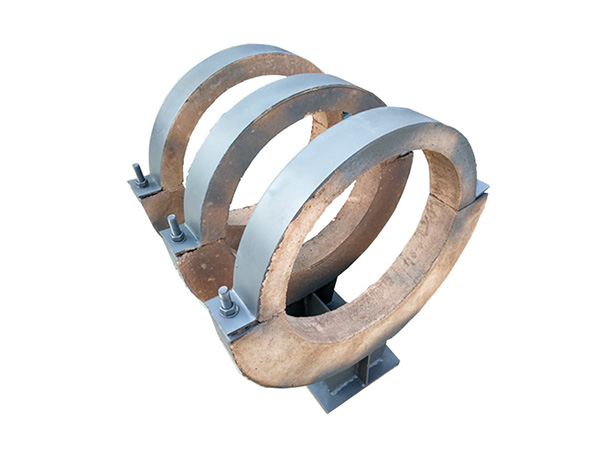Pipeline Insulation Support Mistakes to Avoid
Author:Mingde Time:2025-07-27 14:46:23 Click:156
Introduction: The Importance of Pipeline Insulation Supports
Pipeline insulation supports are critical components in many industries, including oil and gas, chemical processing, power generation, and HVAC systems. Their primary role is to support and secure pipeline systems while providing effective thermal isolation to minimize energy loss. In industrial pipeline systems, heat transfer is a major concern, and the thermal insulation performance of the pipeline directly impacts energy consumption and equipment efficiency. Therefore, developing high-performance pipeline insulation support materials and ensuring correct installation are crucial for improving energy efficiency.
However, several common mistakes are made during the installation of pipeline insulation supports, which not only result in energy inefficiencies but can also compromise the long-term stability of the entire system. This article highlights these common mistakes and provides effective methods for avoiding them, ensuring the optimized performance of pipeline systems.


Common Mistake #1: Ignoring the Selection of Pipe Support Materials
Mistake Analysis:
The selection of pipe support materials should take into account several factors, including the pipelines operating environment, temperature, corrosiveness, and load-bearing requirements. In some cases, improper material selection can lead to poor thermal insulation or insufficient support strength. For instance, using materials not suited for high-temperature environments may lead to heat loss, reducing overall system efficiency.
How to Avoid It:
To avoid this issue, its essential to understand the properties of various materials. When selecting pipe support materials, consider the following:
·For high-temperature environments, materials such as stainless steel or high-temperature alloys are recommended.
·In corrosive environments, opt for materials with strong corrosion resistance to prevent degradation.
·For thermal insulation, choose materials with low thermal conductivity to minimize heat loss.
Common Mistake #2: Ignoring Thermal Expansion of Pipelines
Mistake Analysis:
Pipelines undergo thermal expansion due to temperature fluctuations during operation. If thermal expansion is not considered during the installation of pipeline insulation supports, it may lead to uneven stress distribution, causing pipe deformation or even system failure.
How to Avoid It:
To prevent this issue, the pipe support system should be designed to accommodate thermal expansion:
·Use adjustable supports that can compensate for thermal expansion, ensuring the pipeline remains in optimal condition.
·Design expansion points where the pipeline can move freely as it expands or contracts, relieving thermal stress.
Common Mistake #3: Uneven Insulation Layer Installation
Mistake Analysis:
In some pipeline systems, uneven installation of the insulation layer can occur, leading to areas with excessive heat loss. Uneven insulation directly reduces the thermal performance of the pipeline and impacts energy efficiency.
How to Avoid It:
To prevent uneven insulation:
·Ensure that the insulation layer is evenly distributed around the entire pipeline, avoiding areas that are too thin or too thick.
·Use precise measurement tools during installation to maintain uniform insulation thickness.


Common Mistake #4: Overlooking the Contact Surface Between the Support and the Pipeline
Mistake Analysis:
If the contact surface between the pipe support and the pipeline is not properly isolated, heat transfer between the two components may occur, reducing the effectiveness of thermal insulation and potentially causing damage to the support structure due to thermal expansion.
How to Avoid It:
When installing pipeline insulation supports, ensure that the support-pipe contact surface is appropriately isolated. This can be done by:
·Using thermal pads or insulation materials between the support and the pipeline to reduce heat transfer.
·Properly selecting support materials that minimize thermal conduction.
Common Mistake #5: Incorrect Support Spacing
Mistake Analysis:
Improper spacing of supports can result in uneven loading, potentially leading to pipe deformation or failure. If support points are too close together, installation costs may increase unnecessarily, while if they are too far apart, the pipeline may experience sagging or misalignment.
How to Avoid It:
Correctly calculate the support spacing based on the following factors:
·Pipe material and size, which influence the load and flexibility of the pipeline.
·Operating conditions, such as temperature and pressure, which affect the thermal and mechanical load on the system.
·Design supports with optimal spacing to provide sufficient support without incurring unnecessary costs.
Conclusion: Proper Installation of Pipeline Insulation Supports to Enhance Efficiency
The quality of pipeline insulation support installation is crucial to the thermal efficiency and safety of pipeline systems. By avoiding the common mistakes mentioned above, engineers and construction personnel can significantly enhance the thermal insulation performance, reduce energy consumption, and ensure the long-term stability of the system.
In practice, it is essential to choose appropriate materials, design support systems that account for thermal expansion, ensure uniform insulation installation, and properly space the supports. By following these best practices, industries can optimize pipeline performance, lower energy consumption, and improve system safety.
Closing Summary:
Correct installation of pipeline insulation supports not only enhances thermal performance but also reduces energy losses, simplifies installation, and improves overall safety. With ongoing advancements in material technology, the future of pipeline insulation is moving toward more efficient, cost-effective solutions that help industries optimize their energy use while maintaining high performance and durability.
This concludes the article. By understanding and avoiding common installation mistakes, you can significantly improve the performance and efficiency of your pipeline systems. Feel free to reach out if you have further questions or need assistance in optimizing your pipeline support solutions.
References
GBT/7714:Curti G, Pavone D, Marchionni L, et al. Challenges and lessons learnt from the design, fabrication and installation of pipe walking mitigations[C]//International Conference on Offshore Mechanics and Arctic Engineering. American Society of Mechanical Engineers, 2019, 58813: V05BT04A002.
MLA:Curti, Gianbattista, et al. "Challenges and lessons learnt from the design, fabrication and installation of pipe walking mitigations." International Conference on Offshore Mechanics and Arctic Engineering. Vol. 58813. American Society of Mechanical Engineers, 2019.
APA:Curti, G., Pavone, D., Marchionni, L., Guyon, V., Perrin, F., & Pirinu, G. (2019, June). Challenges and lessons learnt from the design, fabrication and installation of pipe walking mitigations. In International Conference on Offshore Mechanics and Arctic Engineering (Vol. 58813, p. V05BT04A002). American Society of Mechanical Engineers.
 Hot Products
Hot Products
 Contact Us
Contact Us
Contact:
Mobile:+86 +86 19133378808
Website:mingdepipe.com
Address:










